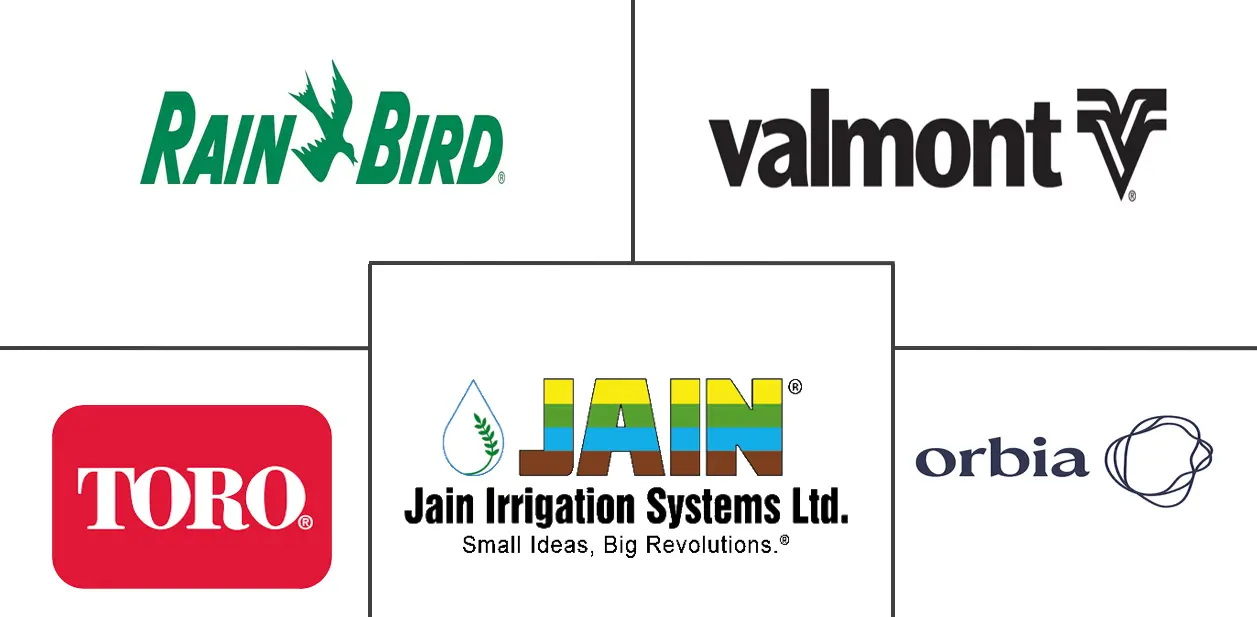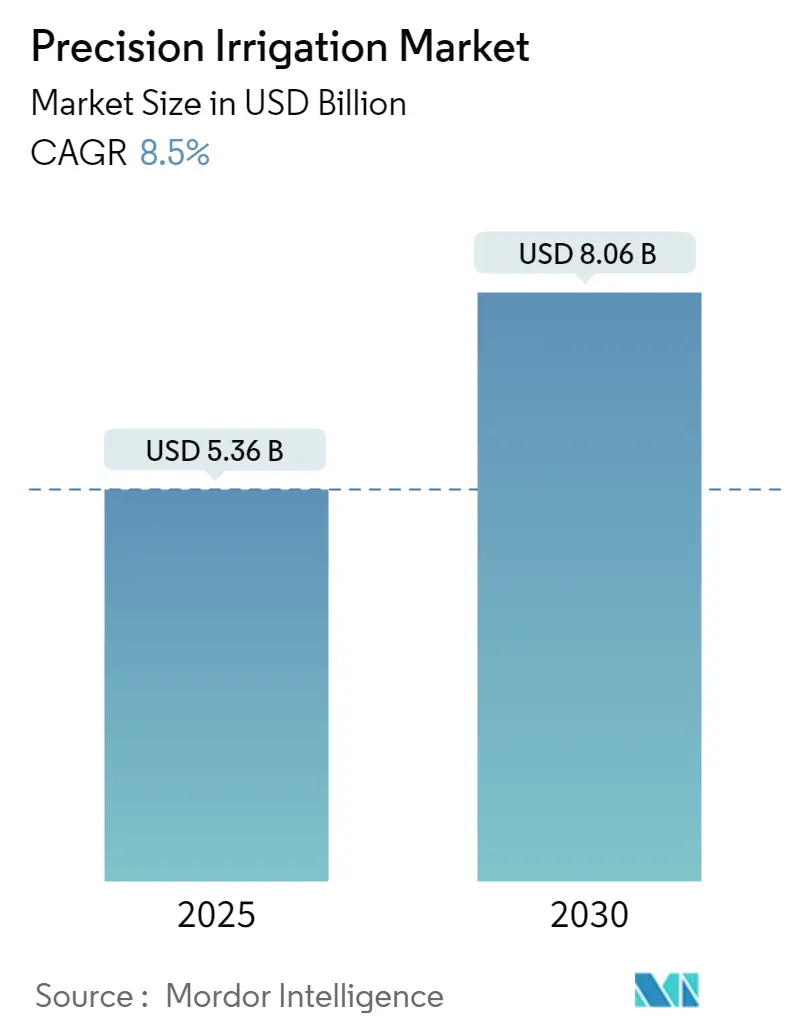
Precision Irrigation Market Analysis
The Precision Irrigation Market size is estimated at USD 5.36 billion in 2025, and is expected to reach USD 8.06 billion by 2030, at a CAGR of 8.5% during the forecast period (2025-2030).
The precision irrigation industry is experiencing significant transformation driven by increasing water scarcity concerns and the growing need for sustainable agricultural practices. Recent studies have demonstrated that subsurface drip irrigation systems can reduce evapotranspiration by up to 26% compared to traditional flood irrigation methods, while simultaneously improving crop water productivity by nearly 25%. The integration of smart irrigation technologies and IoT-enabled solutions has revolutionized agricultural water management practices, allowing farmers to optimize resource utilization through real-time irrigation monitoring and automated control systems. This technological evolution has been particularly evident in the development of advanced soil moisture sensing technologies and weather monitoring systems that enable precise irrigation scheduling.
The industry landscape is being reshaped by strategic consolidations and technological partnerships aimed at enhancing product offerings and market reach. In early 2023, Netafim expanded its digital irrigation solutions portfolio by incorporating advanced soil sensor technology and automated irrigation management system control systems, demonstrating the industry's move toward comprehensive precision agriculture solutions. The emergence of artificial intelligence and machine learning applications in irrigation technology management has enabled more sophisticated decision-making processes, with several major players introducing smart irrigation controllers that can automatically adjust watering schedules based on real-time environmental data.
Government initiatives and infrastructure development programs are playing a crucial role in market expansion, particularly in developing regions. For instance, the European Innovation Partnership on Water (EIP Water) has been actively facilitating the development of innovative irrigation solutions through collaborative action groups and market opportunity creation. Agricultural modernization programs in various countries have included significant funding allocations for precision irrigation adoption, with some governments offering subsidies covering up to 60% of installation costs for modern irrigation systems. These initiatives have been instrumental in driving technology adoption among small and medium-scale farmers.
The industry is witnessing a notable shift toward integrated solutions that combine multiple technologies for optimal performance. Recent innovations include the development of precision mobile drip irrigation (PMDI) systems that combine the efficiency of surface drip irrigation with the flexibility of center pivot systems, achieving irrigation efficiency rates of up to 95% in field trials. Major manufacturers are increasingly focusing on developing customizable solutions that can be adapted to various crop types and field conditions, while also incorporating features for fertigation and crop protection. This trend toward comprehensive solution offerings is expected to continue shaping industry development, with companies investing in research and development to create more efficient and user-friendly systems.
Precision Irrigation Market Trends
Technological Innovation
The precision irrigation market is experiencing significant growth driven by continuous technological advancement in irrigation systems. Major companies like Netafim Ltd, Jain Irrigation Systems Limited, and The Toro Company are introducing innovative solutions such as drip irrigation systems with embedded pipes for simplified installation. These advanced systems are creating sustainable agricultural production while improving the economic position of millions of smallholder farmers. The integration of wireless irrigation technology has been particularly transformative, allowing farmers to control and operate drip irrigation systems remotely while monitoring various parameters in real time.
Mobile-controlled electric motors utilizing automated technology are revolutionizing irrigation practices across the agricultural sector. Companies are increasingly focusing on enhancing the production of advanced automated irrigation systems, with initiatives like the European Innovation Partnership on Water (EIP Water) facilitating the development of innovative solutions to address water challenges. For instance, Nelson Irrigation Corporation's launch of R55VT and R75 End of Pivot Sprinklers demonstrates how technology is being made more affordable and efficient, making precision irrigation machinery more accessible to farmers worldwide.
Water Conservation and Resource Efficiency
Water scarcity has become a critical driver for the adoption of precision irrigation systems, particularly in European countries where water resources are limited. These systems have demonstrated remarkable efficiency, with modern irrigation techniques reducing water wastage by up to 70% compared to traditional irrigation methods. The implementation of smart irrigation technologies has become essential for controlling soil moisture, especially in specialized greenhouse vegetable production, where water management directly impacts crop yield and quality.
The adoption of precision irrigation systems has shown significant results in various applications. For instance, in greenhouse vegetable production, which requires substantial water resources, farmers are increasingly switching to both sprinkler and drip irrigation systems to achieve higher crop productivity while conserving water. This is particularly evident in countries like Belgium, where greenhouse vegetable production reached 405.4 thousand metric tons in 2021, with tomato production accounting for 304.1 thousand metric tons. The success of these systems in water conservation while maintaining high productivity levels has made them increasingly attractive to farmers facing water scarcity challenges.
Labor Cost Reduction and Automation
The rising cost of agricultural labor has emerged as a significant driver for the adoption of precision irrigation systems. Traditional irrigation methods require substantial manual intervention, leading to higher operational costs and reduced efficiency. Precision irrigation systems have demonstrated the ability to reduce irrigation overheads by up to 50% by minimizing the need for manual labor in irrigation operations. This cost reduction is particularly significant for both large-scale and small-scale farming operations, where labor expenses constitute a substantial portion of operational costs.
The automation capabilities of precision irrigation systems provide additional cost benefits beyond direct labor savings. These systems enable farmers to achieve optimal water distribution and timing without constant manual oversight, resulting in estimated cost savings of 10-50% through improved resource utilization. The integration of smart features, such as automated scheduling and remote monitoring, has made these systems particularly attractive to farmers looking to modernize their operations while maintaining competitive operational costs. This automation not only reduces labor requirements but also minimizes human error in irrigation management, leading to more consistent and efficient water application. The growing irrigation automation market is a testament to the increasing demand for such technologies.
Segment Analysis: Type
Sprinkler Irrigation Segment in Precision Irrigation Market
The smart sprinkler irrigation segment continues to dominate the precision irrigation market, holding approximately 45% market share in 2024. This significant market position is driven by the widespread adoption of various sprinkler technologies, including traditional sprinklers, center pivot sprinklers, and lateral move/linear sprinklers. Traditional sprinklers represent the largest sub-segment within smart sprinkler irrigation, particularly popular among medium and small-holding farmers due to their cost-effectiveness and ease of implementation. The segment's strength is further reinforced by continuous product innovations from major companies like Netafim India, which launched the 'Flexi Sprinkler Kit' featuring robust D-Net 3D diffusion arm technology for enhanced water distribution uniformity. The versatility of sprinkler systems across varying topographic conditions and their suitability for a wide range of applications, from home gardens to large-scale crop irrigation, continues to drive their market dominance.
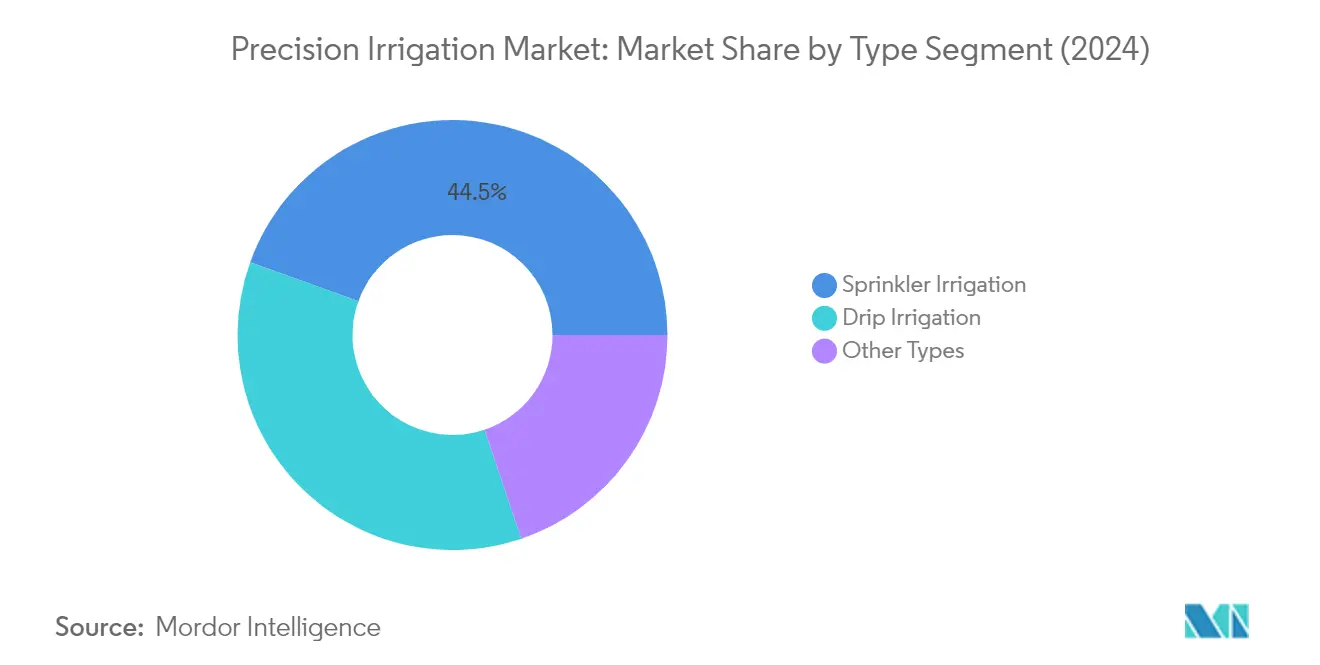
Drip Irrigation Segment in Precision Irrigation Market
The drip irrigation segment is experiencing the fastest growth in the precision irrigation market, with a projected growth rate of approximately 10% during 2024-2029. This accelerated growth is attributed to its superior water-use efficiency, with the ability to reduce water usage by almost 70% compared to traditional irrigation methods. The segment's growth is driven by technological advancements in surface drip irrigation, sub-surface drip irrigation, and precision mobile drip irrigation systems. The increasing adoption of drip irrigation in water-scarce regions, coupled with its ability to deliver water and nutrients directly to the crop's root zone, makes it particularly attractive for modern agricultural practices. The segment is also benefiting from government initiatives promoting water conservation in agriculture and the rising awareness among farmers about the benefits of precision irrigation techniques.
Remaining Segments in Precision Irrigation Market
Other types of precision irrigation systems, including boom irrigation and specialized irrigation technologies, play a crucial role in specific agricultural applications. These systems incorporate advanced strategies such as regulated deficit irrigation (RDI), partial root drying (PRD), and sustained deficit irrigation (SDI). Boom irrigation systems have emerged as a significant technological advancement, particularly effective for plug or cell trays, pot-to-pot spaced plants, and cutting in beds. These alternative systems offer unique advantages in terms of efficiency and precision in watering, particularly in greenhouse environments and specialized agricultural settings, complementing the mainstream sprinkler and drip irrigation systems in the market.
Segment Analysis: Crop Type
Field Crops Segment in Precision Irrigation Market
Field crops represent the dominant segment in the precision irrigation market, commanding approximately 43% of the total market share in 2024. This significant market position is driven by the extensive cultivation of water-intensive crops like cereals, particularly rice and maize, which require sophisticated irrigation control system solutions. The segment's dominance is further strengthened by increasing global population pressures that demand enhanced cereal production worldwide. Major agricultural regions, particularly in the United States where Nebraska accounts for about 15% of the country's total irrigated land, have witnessed substantial adoption of controlled irrigation systems for field crops. The prevalence of irrigated acreage in such regions is attributed to abundant groundwater resources, with many areas overlying significant aquifers that support extensive field crop cultivation.
Orchards and Vineyards Segment in Precision Irrigation Market
The orchards and vineyards segment is experiencing the most rapid growth in the precision irrigation market, with a projected growth rate of approximately 11% from 2024 to 2029. This accelerated growth is primarily driven by the increasing adoption of precision irrigation technologies in fruit cultivation and vineyard management. The segment's growth is particularly notable in regions with water scarcity issues, where precision irrigation helps maintain optimal soil moisture conditions for high-value fruit crops. Studies have demonstrated that the implementation of precision irrigation devices has significantly boosted fruit crop productivity, with some regions reporting productivity increases of over 43%. The adoption of precision irrigation in vineyards has been particularly strong in major wine-producing regions, where it has proven essential for quality control and water conservation in grape cultivation.
Remaining Segments in Crop Type Segmentation
The plantation crops and turf and ornamentals segments complete the precision irrigation market landscape, each serving distinct agricultural needs. The plantation crops segment, which includes large-scale estate crops such as cotton, tea, coffee, and sugarcane, has seen steady adoption of precision irrigation systems, particularly in regions focusing on sustainable water management practices. Meanwhile, the turf and ornamentals segment, though smaller in market share, plays a crucial role in landscaping and sports ground maintenance, where automated sprinkler systems are essential for maintaining healthy turf and ornamental plants. These segments are particularly important in regions with developing agricultural sectors and growing urbanization, where both commercial agriculture and landscaping demands drive the adoption of precision irrigation technologies.
Precision Irrigation Market Geography Segment Analysis
Precision Irrigation Market in North America
North America represents a mature and technologically advanced market for precision irrigation systems, driven by the increasing adoption of smart irrigation practices and water conservation initiatives. The United States, Canada, and Mexico form the key markets in this region, with varying levels of adoption based on their agricultural landscapes and technological readiness. The region benefits from strong government support through agricultural subsidies and technological advancement programs, encouraging farmers to adopt modern irrigation technology practices. Water scarcity concerns and the need for sustainable farming practices continue to drive market growth across these countries.
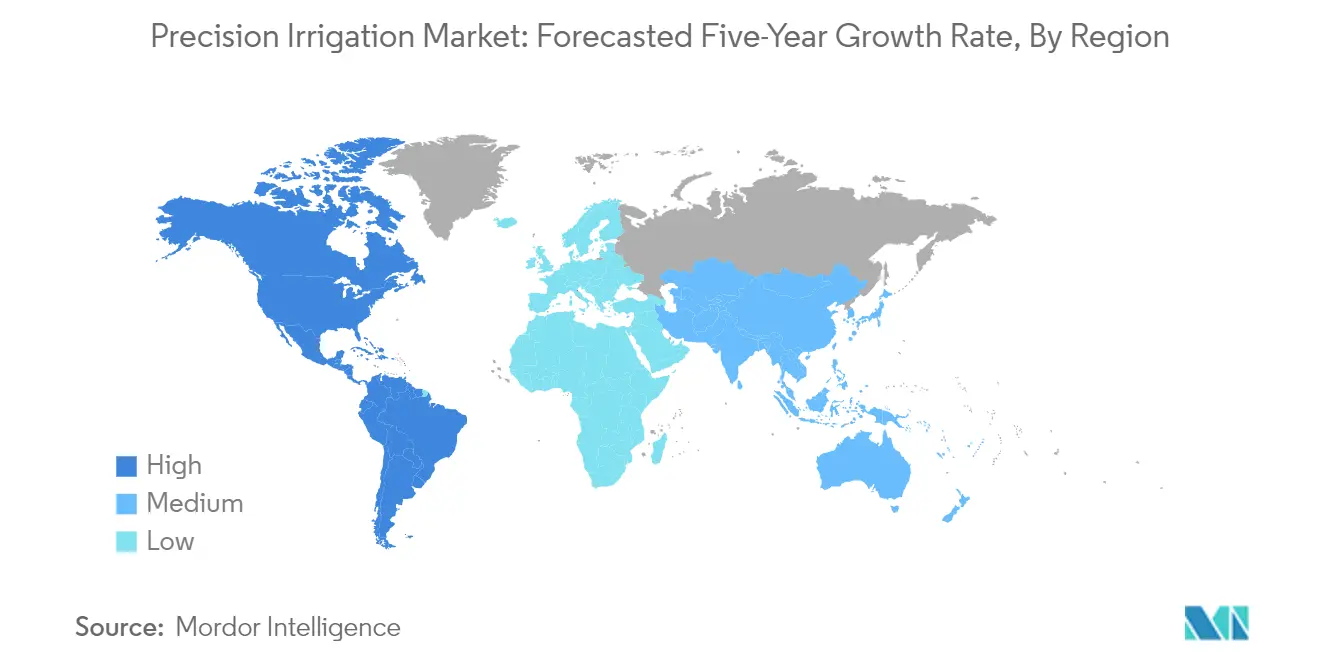
Precision Irrigation Market in United States
The United States dominates the North American precision irrigation market, accounting for approximately 60% of the regional market share. The country's leadership position is attributed to its vast agricultural land, advanced farming practices, and strong technological infrastructure. American farmers have been early adopters of precision irrigation technologies, particularly in water-stressed regions like California and the Midwest. The availability of government subsidies and flexible loan programs has enabled even small-scale farmers to invest in advanced drip irrigation systems. The country's robust agricultural research and development ecosystem continues to drive innovations in precision irrigation technologies.
Precision Irrigation Market in Canada
Canada emerges as the fastest-growing market in North America, with a projected growth rate of approximately 10% during 2024-2029. The country's precision irrigation market is driven by increasing awareness about water conservation and the need to optimize agricultural productivity in its varying climatic conditions. Canadian farmers are increasingly adopting precision irrigation systems, particularly in regions focusing on high-value crops. The government's support through various agricultural modernization programs and environmental initiatives has been instrumental in driving market growth. The country's focus on sustainable farming practices and increasing investment in agricultural technology continue to create favorable conditions for market expansion.
Precision Irrigation Market in Europe
Europe represents a significant market for precision irrigation systems, characterized by diverse agricultural practices and varying adoption rates across different regions. The market is particularly strong in countries like Spain, France, Italy, Germany, the United Kingdom, and Russia, with each country having unique agricultural needs and water management challenges. The European Union's strong focus on sustainable agriculture and water conservation has been a key driver for market growth. The region's emphasis on technological innovation and precision farming has created a favorable environment for the adoption of advanced agricultural irrigation systems.
Precision Irrigation Market in Spain
Spain leads the European precision irrigation market, commanding approximately 21% of the regional market share. The country's leadership position is driven by its extensive horticultural and vineyard sectors, which require precise water management systems. Spanish farmers have been particularly active in adopting drip irrigation systems, especially in water-scarce regions. The country's strong focus on water conservation in agriculture, coupled with government support for modernizing irrigation infrastructure, has contributed to its market dominance. The Mediterranean climate and the need for efficient water usage in crop production continue to drive market growth.
Precision Irrigation Market in Russia
Russia demonstrates the highest growth potential in the European market, with a projected growth rate of approximately 9% during 2024-2029. The country's vast agricultural land and ongoing modernization of farming practices present significant opportunities for precision irrigation systems. The Russian agricultural sector's focus on improving productivity and water use efficiency has been driving the adoption of modern irrigation technology. The government's initiatives to support agricultural modernization and increase crop yields have created a favorable environment for market growth. The country's expanding commercial farming sector and increasing awareness about water conservation continue to drive market expansion.
Precision Irrigation Market in Asia-Pacific
The Asia-Pacific region represents a dynamic market for precision irrigation systems, characterized by diverse agricultural practices and varying levels of technological adoption. Countries like China, India, Japan, Australia, and South Korea are key markets in this region, each with unique agricultural requirements and challenges. The region's large agricultural sector, coupled with increasing awareness about water conservation and sustainable farming practices, drives market growth. Government initiatives promoting modern farming techniques and water-efficient micro irrigation systems have been instrumental in market development.
Precision Irrigation Market in China
China leads the Asia-Pacific precision irrigation market, driven by its extensive agricultural sector and government support for modernizing farming practices. The country's focus on food security and sustainable agriculture has accelerated the adoption of precision irrigation systems. Chinese farmers are increasingly embracing modern irrigation technologies to address water scarcity challenges and improve agricultural productivity. The government's initiatives to promote water-efficient farming practices and support for agricultural modernization continue to drive market growth.
Precision Irrigation Market in India
India emerges as the fastest-growing market in the Asia-Pacific region, driven by increasing government support and growing awareness about water-efficient farming practices. The country's agricultural sector is witnessing a significant transformation with the adoption of modern irrigation technologies. Indian farmers are increasingly recognizing the benefits of precision irrigation systems in improving crop yields and water use efficiency. Government initiatives promoting micro irrigation systems and subsidies for modern farming equipment continue to drive market growth.
Precision Irrigation Market in South America
South America represents a growing market for precision irrigation systems, with Brazil and Argentina being the key markets in the region. The market is driven by the region's extensive agricultural activities and increasing focus on modernizing farming practices. Brazil emerges as both the largest and fastest-growing market in the region, supported by its vast agricultural land and government initiatives promoting modern irrigation technologies. The region's agricultural sector's focus on improving productivity and water use efficiency continues to drive the adoption of precision irrigation systems. The increasing awareness about sustainable farming practices and water conservation among South American farmers contributes to market growth.
Precision Irrigation Market in Africa
Africa presents significant opportunities for precision irrigation systems, with South Africa leading the regional market. The continent's agricultural sector is gradually embracing modern irrigation technologies to address water scarcity challenges and improve crop yields. South Africa emerges as both the largest and fastest-growing market in the region, driven by its relatively advanced agricultural sector and increasing adoption of modern farming practices. The region's focus on improving agricultural productivity and water use efficiency continues to drive market growth. Government initiatives and international support for agricultural modernization contribute to the increasing adoption of precision irrigation systems across the continent.
Precision Irrigation Industry Overview
Top Companies in Precision Irrigation Market
The precision irrigation market features several established global players who are actively shaping industry dynamics through various strategic initiatives. Product innovation remains the dominant strategy, with companies focusing on developing advanced irrigation technology, smart control systems, and digital farming solutions to enhance water efficiency and crop yields. Operational agility is demonstrated through rapid adaptation to regional market needs and customization of solutions for different crop types and farming conditions. Companies are expanding their geographical presence through strategic partnerships with local distributors and dealers while also investing in manufacturing facilities across key agricultural regions. The industry witnesses regular collaboration between technology providers and irrigation specialists to integrate IoT, artificial intelligence, and automation capabilities into irrigation systems, driving the evolution of smart farming practices.
Consolidated Market Led By Global Leaders
The precision irrigation market exhibits a highly consolidated structure dominated by multinational corporations with extensive manufacturing and distribution networks. These market leaders leverage their technological expertise, brand reputation, and comprehensive product portfolios to maintain their competitive positions. The landscape is characterized by a mix of pure-play irrigation specialists and diversified agricultural equipment manufacturers, with the former focusing on innovative irrigation solutions and the latter offering integrated farming solutions. The market has witnessed significant consolidation through strategic mergers and acquisitions, particularly targeting companies with complementary technologies or strong regional presence.
The competitive dynamics are influenced by the presence of strong regional players who have a deep understanding of local farming practices and established relationships with farming communities. Market leaders are increasingly pursuing vertical integration strategies to strengthen their control over the value chain and enhance their ability to offer end-to-end solutions. The industry also sees frequent collaborations between established players and technology startups, particularly in developing smart irrigation company solutions and precision agriculture platforms.
Innovation and Service Drive Market Success
Success in the precision irrigation market increasingly depends on companies' ability to offer comprehensive solutions that combine hardware, software, and advisory services. Incumbent players are focusing on developing integrated platforms that provide data-driven insights for irrigation management, while also expanding their service networks to provide superior after-sales support. The ability to demonstrate a clear value proposition through water savings, yield improvements, and operational efficiency gains is becoming crucial for market success. Companies are also investing in building strong relationships with agricultural institutions and research organizations to enhance their innovation capabilities and credibility.
For new entrants and challenger brands, success lies in identifying and serving underserved market segments or regions with specialized solutions. The focus needs to be on developing cost-effective solutions that address specific regional challenges while maintaining quality standards. Building strong distribution networks and providing comprehensive training and support to farmers is essential for gaining market acceptance. Companies must also stay ahead of evolving regulatory requirements related to water usage and environmental protection while developing solutions that align with sustainable farming practices. The integration of digital irrigation and connected irrigation systems is becoming increasingly important in meeting these demands.
Precision Irrigation Market Leaders
-
Jain Irrigation Systems Ltd
-
The Toro Company.
-
Valmont Industries
-
Rain Bird Corporation
-
Orbia (Netafim Limited)
- *Disclaimer: Major Players sorted in no particular order
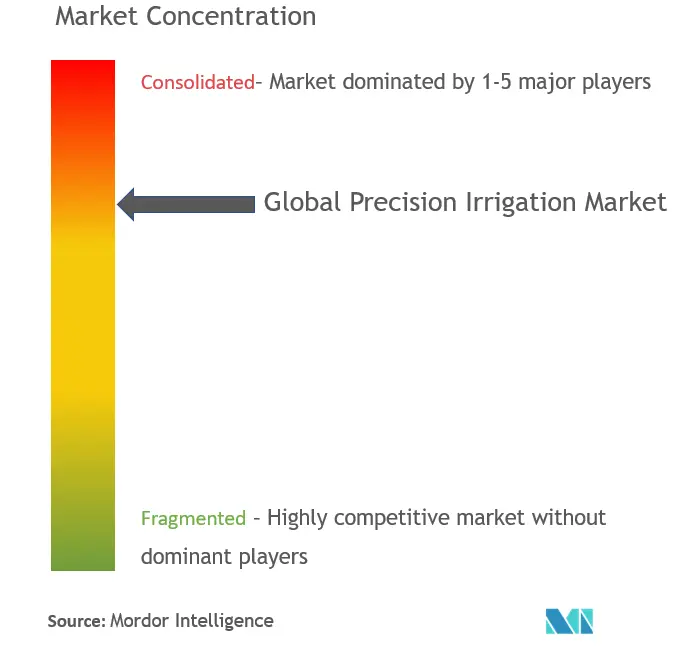
Precision Irrigation Market News
- September 2023: Jain Irrigation Systems Limited partnered with the Water Management and Plumbing Skills Council (WMPSC) to boost skills and foster innovation in water management, including drip water management and plumbing. The core purpose of this partnership is to share knowledge, experiences, resources, and connections within the water and plumbing industries, which helps the company.
- June 2022: Rivulis Irrigation India Ltd and Jain Irrigation Systems Limited merged their businesses to become one of the largest global irrigation system providers.
- February 2022: Netafim Limited introduced the AlphaDisc Filter to the US market, protecting irrigation systems against clogging caused by organic contaminants. This innovation has the potential to enable growers to achieve more uniform irrigation, ultimately leading to increased productivity.
Precision Irrigation Market Report - Table of Contents
1. INTRODUCTION
- 1.1 Study Assumptions and Market Definition
- 1.2 Scope of the Study
2. RESEARCH METHODOLOGY
3. EXECUTIVE SUMMARY
4. MARKET DYNAMICS
- 4.1 Market Overview
- 4.2 Market Drivers
- 4.3 Market Restraints
-
4.4 Porter's Five Force Analysis
- 4.4.1 Bargaining Power of Suppliers
- 4.4.2 Bargaining Power of Buyers
- 4.4.3 Threat of New Entrants
- 4.4.4 Threat of Substitutes
- 4.4.5 Degree of Competition
5. MARKET SEGMENTATION
-
5.1 Type
- 5.1.1 Sprinkler Irrigation
- 5.1.1.1 Traditional Sprinklers
- 5.1.1.2 Center Pivot Sprinklers
- 5.1.1.3 Lateral Move/ Linear Sprinklers
- 5.1.2 Drip Irrigation
- 5.1.2.1 Surface Drip Irrigation
- 5.1.2.2 Sub-Surface Drip Irrigation
- 5.1.2.3 Precision Mobile Drip Irrigation
- 5.1.3 Other Types
-
5.2 Crop Type
- 5.2.1 Field Crops
- 5.2.2 Plantation Crops
- 5.2.3 Orchards and Vineyards
- 5.2.4 Turf and Ornamentals
-
5.3 Geography
- 5.3.1 North America
- 5.3.1.1 United States
- 5.3.1.2 Canada
- 5.3.1.3 Mexico
- 5.3.1.4 Rest of North America
- 5.3.2 Europe
- 5.3.2.1 Germany
- 5.3.2.2 United Kingdom
- 5.3.2.3 France
- 5.3.2.4 Spain
- 5.3.2.5 Italy
- 5.3.2.6 Russia
- 5.3.2.7 Rest of Europe
- 5.3.3 Asia-Pacific
- 5.3.3.1 China
- 5.3.3.2 India
- 5.3.3.3 Japan
- 5.3.3.4 Australia
- 5.3.3.5 South Korea
- 5.3.3.6 Rest of Asia-Pacific
- 5.3.4 South America
- 5.3.4.1 Brazil
- 5.3.4.2 Argentina
- 5.3.4.3 Rest of South America
- 5.3.5 Africa
- 5.3.5.1 South Africa
- 5.3.5.2 Rest of Africa
6. COMPETITIVE LANDSCAPE
- 6.1 Most Adopted Strategies
- 6.2 Market Share Analysis
-
6.3 Company Profiles
- 6.3.1 Jain Irrigation Systems Ltd
- 6.3.2 Lindsay Corporation
- 6.3.3 Nelson Irrigation Corporation
- 6.3.4 Netafim Ltd
- 6.3.5 Rain Bird Corporation
- 6.3.6 Rivulis Irrigation Ltd
- 6.3.7 The Toro Company
- 6.3.8 Valmont Industries Inc.
- 6.3.9 Mahindra EPC Industries Limited
- 6.3.10 T-l Irrigation Co.
- 6.3.11 Deere & Company
- *List Not Exhaustive
7. MARKET OPPORTUNITIES AND FUTURE TRENDS
Precision Irrigation Industry Segmentation
Precision irrigation is an innovative and sustainable agricultural method that delivers water and nutrients to the plant at the precise time and location in small, measured quantities, providing optimal growing conditions. The precision irrigation market is segmented by type (drip irrigation, sprinkler irrigation, and other types), crop type (field crops, plantation crops, orchards and vineyards, and turf and ornamentals), and geography (North America, Europe, Asia-Pacific, South America, and Africa). The report offers market estimation and forecasts in terms of Value (USD) for all of the above segments.
| Type | Sprinkler Irrigation | Traditional Sprinklers | |
| Center Pivot Sprinklers | |||
| Lateral Move/ Linear Sprinklers | |||
| Drip Irrigation | Surface Drip Irrigation | ||
| Sub-Surface Drip Irrigation | |||
| Precision Mobile Drip Irrigation | |||
| Other Types | |||
| Crop Type | Field Crops | ||
| Plantation Crops | |||
| Orchards and Vineyards | |||
| Turf and Ornamentals | |||
| Geography | North America | United States | |
| Canada | |||
| Mexico | |||
| Rest of North America | |||
| Europe | Germany | ||
| United Kingdom | |||
| France | |||
| Spain | |||
| Italy | |||
| Russia | |||
| Rest of Europe | |||
| Asia-Pacific | China | ||
| India | |||
| Japan | |||
| Australia | |||
| South Korea | |||
| Rest of Asia-Pacific | |||
| South America | Brazil | ||
| Argentina | |||
| Rest of South America | |||
| Africa | South Africa | ||
| Rest of Africa | |||
Precision Irrigation Market Research FAQs
How big is the Precision Irrigation Market?
The Precision Irrigation Market size is expected to reach USD 5.36 billion in 2025 and grow at a CAGR of 8.5% to reach USD 8.06 billion by 2030.
What is the current Precision Irrigation Market size?
In 2025, the Precision Irrigation Market size is expected to reach USD 5.36 billion.
Who are the key players in Precision Irrigation Market?
Jain Irrigation Systems Ltd, The Toro Company., Valmont Industries, Rain Bird Corporation and Orbia (Netafim Limited) are the major companies operating in the Precision Irrigation Market.
Which is the fastest growing region in Precision Irrigation Market?
Asia Pacific is estimated to grow at the highest CAGR over the forecast period (2025-2030).
Which region has the biggest share in Precision Irrigation Market?
In 2025, the North America accounts for the largest market share in Precision Irrigation Market.
What years does this Precision Irrigation Market cover, and what was the market size in 2024?
In 2024, the Precision Irrigation Market size was estimated at USD 4.90 billion. The report covers the Precision Irrigation Market historical market size for years: 2019, 2020, 2021, 2022, 2023 and 2024. The report also forecasts the Precision Irrigation Market size for years: 2025, 2026, 2027, 2028, 2029 and 2030.
Our Best Selling Reports
Precision Irrigation Market Research
Mordor Intelligence provides a comprehensive analysis of the precision irrigation industry. We leverage our extensive expertise in agricultural water management and irrigation technology research. Our detailed report examines the shift from traditional to smart irrigation systems. This includes digital irrigation solutions and intelligent irrigation implementations. The analysis covers various technologies such as IoT irrigation, wireless irrigation, and variable rate irrigation. It also explores the integration of soil moisture sensing and irrigation monitoring capabilities. The report, available as an easy-to-download PDF, offers in-depth insights into micro irrigation systems and automated irrigation solutions.
Our research benefits stakeholders across the agricultural irrigation spectrum. This includes manufacturers of smart sprinkler systems and providers of controlled irrigation solutions. The report examines irrigation control systems and irrigation management systems. It also analyzes the growing adoption of drip irrigation technologies. Stakeholders gain valuable insights into precision irrigation market dynamics. This includes detailed smart irrigation market size analysis and emerging trends in irrigation automation. The study also covers developments in connected irrigation and micro irrigation market segments. It provides actionable intelligence for strategic decision-making in the irrigation technology sector.

